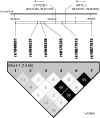Confirmation of association between multiple sclerosis and CYP27B1
- PMID: 20648053
- PMCID: PMC3002863
- DOI: 10.1038/ejhg.2010.113
Confirmation of association between multiple sclerosis and CYP27B1
Abstract
Multiple sclerosis, MS (OMIM No. 126200), is a complex inflammatory disease that is characterized by lesions in the central nervous system. Both genes and other environmental factors influence disease susceptibility. One of the environmental factors that has been implicated in MS and autoimmune disease, such as type 1 diabetes, is vitamin D deficiency, in which patients have lower levels of 25-hydroxyvitamin D3 (25-OHD(3)) in blood than do controls. Previtamin D(3) is produced in the skin, and turned into 25-OHD(3) in the liver. In the kidney, skin and immune cells, 25-OHD(3) is turned into bioactive 1,25(OH)(2)D(3) by the enzyme coded by CYP27B1 (cytochrome P450 family 27 subfamily B peptide 1) on chromosome 12q13.1-3. 1,25(OH)(2)D(3) binds to the vitamin D receptor, expressed in T cells and antigen-presenting cells. 1,25(OH)(2)D(3) has a suppressive role in the adaptive immune system, decreasing T-cell and dendritic cell maturation, proliferation and differentiation, shifting the balance between T-helper 1 (Th1) and Th2 cells in favor of Th2 cells and increasing the suppressive function of regulatory T cells. Rs703842 in the 12q13-14 region was associated with MS in a recent study by the Australian and New Zealand Multiple Sclerosis Genetics Consortium (ANZgene). We show associations with three SNPs in this region in our Swedish materials (2158 cases, 1759 controls) rs4646536, rs10877012 and rs10877015 (P=0.01, 0.01 and 3.5 × 10(-3), respectively). We imputed rs703842 SNP and performed a joint analysis with the ANZgene results, reaching a significant association for rs703842 (P=5.1 × 10(-11); odds ratio 0.83; 95% confidence interval 0.79-0.88). Owing to its close association with 25-OHD(3), our results lend further support to the role of vitamin D in MS pathology.
Figures


References
-
- Kurtzke JF. Epidemiology of multiple sclerosis. Does this really point toward an etiology? Lectio Doctoralis. Neurol Sci. 2000;21:383–403. - PubMed
-
- Acheson ED, Bachrach CA, Wright FM. Some comments on the relationship of the distribution of multiple sclerosis to latitude, solar radiation, and other variables. Acta Psychiatr Scand. 1960;35 (Suppl:132–147. - PubMed
-
- van der Mei IA, Ponsonby AL, Blizzard L, Dwyer T. Regional variation in multiple sclerosis prevalence in Australia and its association with ambient ultraviolet radiation. Neuroepidemiology. 2001;20:168–174. - PubMed
-
- Bayes HK, Weir CJ, O'Leary C. Timing of birth and risk of multiple sclerosis in the Scottish population. Eur Neurol. 2010;63:36–40. - PubMed
Publication types
MeSH terms
Substances
LinkOut - more resources
Full Text Sources
Medical

